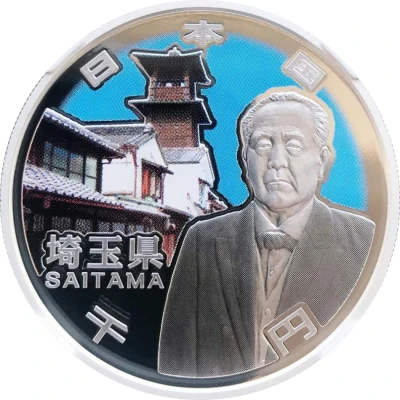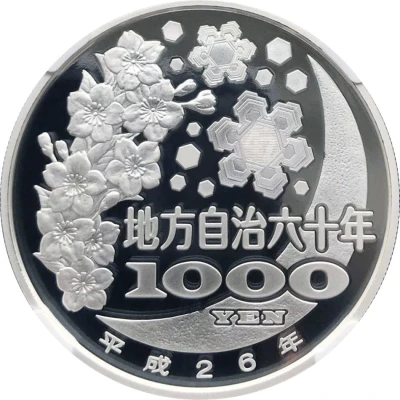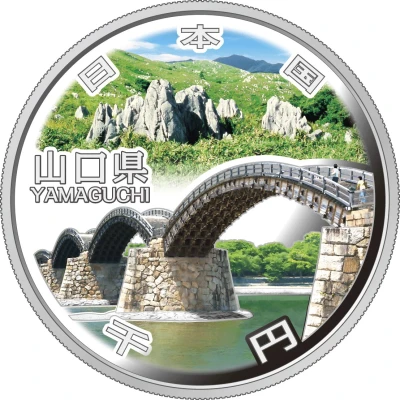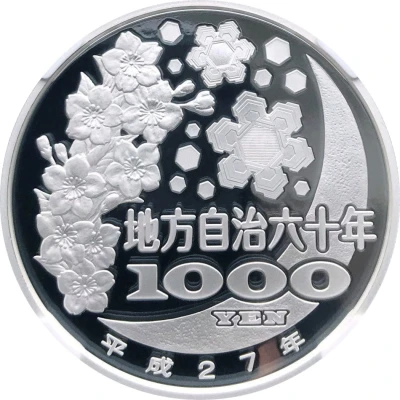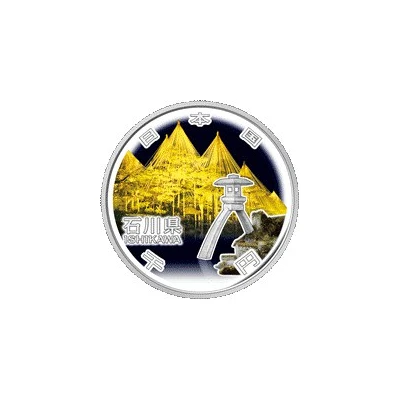
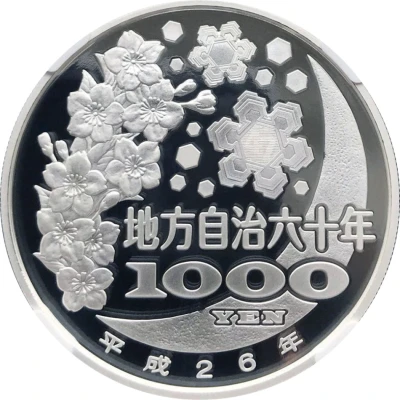

Obverse © Japan Mint – Reverse © coinsupermarket2012
1000 Yen - Heisei Ishikawa
26 (2014) year| Silver (.999) | 31.1 g | 40.0 mm |
| Issuer | Japan |
|---|---|
| Emperor | Heisei (1989-2019) |
| Type | Non-circulating coin |
| Year | 26 (2014) |
| Calendar | Japanese - Heisei era |
| Value | 1000 Yen 1000 JPY = USD 6.72 |
| Currency | Yen (1871-date) |
| Composition | Silver (.999) |
| Weight | 31.1 g |
| Diameter | 40.0 mm |
| Thickness | 3.5 mm |
| Shape | Round |
| Technique | Milled, Coloured |
| Orientation | Medal alignment ↑↑ |
| Updated | 2024-10-05 |
| Numista | N#123682 |
|---|---|
| Rarity index | 86% |
Reverse
Cherry blossoms, crescent and snowflakes.
Latent images in largest snowflake.
Lettering:
(47/60)
地方自治六十年
1000
YEN
平成26年
Translation:
60 years of local autonomy
1000
Yen
Year 26 of Heisei
Edge
Slanted reeding right
Comment
Kenrokuen Garden is known as a representative traditional Japanese garden made by a feudal lord in the Edo period (1603-1868), it is ranked as one of the three most beautiful gardens in Japan. It was designated as a Special Place of Scenic Beauty of the nation in 1985. The inside of the garden has been illuminated in each season since 1997. Especially, illumination in autumn and winter, where ropes protecting trees from snow (yukizuri) are lighten up out of the darkness.Kotoji stone lantern is placed in the northern shore of the Kasumigaike pond, it is known as a symbol of the Kenrokuen Garden. It is said that its name was derived from “kotoji,” a bridge for strings of the Japanese harp (koto), because their shapes with two legs are similar to each other.
Yukizuri, ropes set around trees in a cone-shape to protect them from the weight of snow, is famous as feature of winter in Hokuriku region, to which Ishikawa prefecture belongs. In Kenrokuen Garden, ropes are set by landscape gardeners from November 1st every year.
Interesting fact
The 1000 Yen - Heisei (Ishikawa) 26 (2014) coin from Japan features a unique design that showcases the country's rich cultural heritage. The obverse side of the coin depicts a stunning image of a traditional Japanese garden, complete with intricately designed rocks, ponds, and trees. The reverse side features the Imperial Seal of Japan, which is a symbol of the country's rich history and tradition. The coin's design is a beautiful representation of Japan's commitment to preserving its cultural heritage and traditions.
Price
| Date | Mintage | VG | F | VF | XF | AU | UNC |
|---|---|---|---|---|---|---|---|
| 26 (2014) | 100000 | - | - | - | - | - | - |
Values in the table are based on evaluations by sales realized on Internet platforms. They serve as an indication only for 1000 Yen - Heisei (Ishikawa) 26 (2014) coin.
